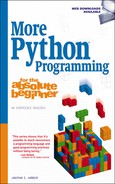Book Description
What better way is there to learn a programming language than with a game-oriented approach? If you ask the many readers that have made this book's prequel, PYTHON PROGRAMMING FOR THE ABSOLUTE BEGINNER, a bestseller, they'll tell you - there isn't one. MORE PYTHON PROGRAMMING FOR THE ABSOLUTE BEGINNER offers readers more practice, more exercises, and slightly more advanced instruction in Python programming, all while using the game-focused examples and projects that have proven to be both effective and fun. It picks up where its prequel leaves off, addressing data structures, file handling, exceptions, object oriented programming, GUI programming, multimedia programming, name spaces, and program planning. Following a deliberate, logical progression of topics that cover increasingly complex subject matter, this is a powerful resource that will arm readers with an in-depth knowledge of the Python language.
Table of Contents
- Copyright
- Acknowledgments
- About the Author
- Introduction
- Chapters
- 1. Python Has Class
- 2. Getting Started with Pygame: The Pie Game
- 3. File I/O, Data, and Fonts: The Trivia Game
- 4. User Input: The Bomb Catcher Game
- 5. Math and Graphics: The Analog Clock Demo
- 6. Bitmap Graphics: The Orbiting Spaceship Demo
- 7. Animation with Sprites: The Escape the Dragon Game
- 8. Sprite Collision Detection: The Zombie Mob Game
- 9. Arrays, Lists, and Tuples: The Block Breaker Game
- 10. Timing and Sound: The Oil Spill Game
- 11. Program Logic: The Snake Game
- 12. Trigonometry: The Tank Battle Game
- 13. Random Terrain: The Artillery Gunner Game
- 14. More of Everything: The Dungeon Role–Playing Game
- Appendix A: Installing Python and Pygame
- Appendix B: Pygame Key Codes
- Book Resources
- Styles
- Chapters
- 1. Python Has Class
- 2. Getting Started with Pygame: The Pie Game
- 3. File I/O, Data, and Fonts: The Trivia Game
- 4. User Input: The Bomb Catcher Game
- 5. Math and Graphics: The Analog Clock Demo
- 6. Bitmap Graphics: The Orbiting Spaceship Demo
- 7. Animation with Sprites: The Escape the Dragon Game
- 8. Sprite Collision Detection: The Zombie Mob Game
- 9. Arrays, Lists, and Tuples: The Block Breaker Game
- 10. Timing and Sound: The Oil Spill Game
- 11. Program Logic: The Snake Game
- 12. Trigonometry: The Tank Battle Game
- 13. Random Terrain: The Artillery Gunner Game
- 14. More of Everything: The Dungeon Role-Playing Game
- A. Installing Python and Pygame
- B. Pygame Key Codes
